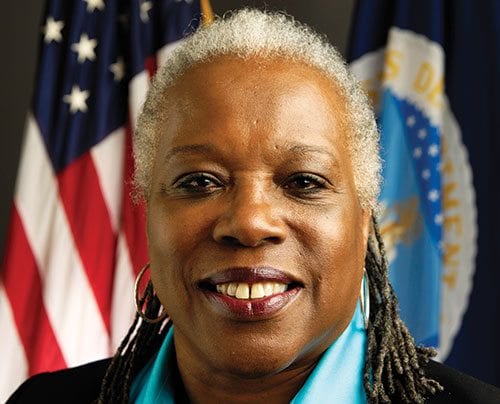
Have you ever seen a “MyPlate” icon on a poster at your local school, church, community center, food bank, or library? This popular insignia is a part of a U.S. Department of Agriculture initiative designed to immerse American children in a healthy lifestyle that consists of a balanced and nourishing diet.
With the summer soon approaching, representatives at national and regional levels of the USDA’s Food and Nutrition Service met with community members at John F. Kennedy Federal Building on March 10 to discuss the future and goals of the summer feeding programs in Massachusetts.
Food and Nutrition Service Administrator Audrey Rowe spoke with the Banner to talk about the Summer Feeding Programs for children of Massachusetts. The following Q-and-A has been slightly edited for clarity.
What is the summer feeding program and why do we need it?
The summer feeding program was created back in 1968 with the recognition that food insecurity increases during the summer because children did not have access to free lunch that they had during the school year.
And many children lack access [to meals] because of a number of challenges: if they’re in rural areas, it’s transportation. There’s no bus transportation when school is out when you’re in a rural area. In urban areas, parents may be concerned about crime and gang activity and so they don’t send their children to feeding sites.
So what we try and do during the summer now is to increase the number of sites and locations where children can go to have a nutritious lunch and breakfast.
How does Massachusetts design its summer feeding sites?
In Massachusetts you don’t have as much of a rural community as some other states. It’s more urban. So how do we get more sites into the urban area? … There are HUD [U.S. Department of Housing and Urban Development] sites and there are subsidized housing sites throughout Massachusetts, so those sites can provide summer meals. Last year they did some, and this year we’re hoping to expand. … Many of the faith-based institutions have vacation bible schools; those can be sites for summer feeding… [And] libraries came up last year. We look for and work with sponsors in the state — groups like Feeding America, Share Our Strength, and universities. In some states, universities have made available their cafeterias … So there are a variety of ways a summer feeding site can be designed.
What are the challenges to implementing the Summer Feeding Program in Massachusetts for this summer?
The biggest difficulty is finding sites in different parts of the state. One of the things that we will be looking at over the next few days is where poverty is located, and … that’s where we want to see and aggressively identify potential locations.
Sodium is also a very challenging area for many schools and communities. There is an attempt being made to restrict and further reduce sodium content. … This summer we will be making sure again that the food that is being provided is lower in sodium than children are traditionally exposed to at home.
How many meals were served in 2013 and 2014?
The summer feeding programs have to report to the state on a daily basis how many meals they have served. And we’re able to add that up each month to see what the number of meals served during the previous month has been. By the end of the summer last year we had served 187 million meals to children from June to August across the United States. This year we’re aiming for 200 million nationwide. As for the number of meals served in Massachusetts – in 2013 they were in excess of 2.5 million, and in 2014 they were in excess of 2.7 million. So Massachusetts has had a growth in the number of meals served. The number of sites they had in 2013 was 922, and the number of sites they had in 2014 was 941 … Normally every year we ask for a ten percent increase.”
How long does it take to implement this new eating habit?
You’re changing behavior from the top down. Food Service directors, agencies, food service staff at the school level – you’re moving all these people from the types of food that they’ve prepared for students for years. They now have to prepare foods that are very different in terms of the fat content and the level of whole grains. Another part of the process is finding products that meet the palette that children are use to. All of these elements factor into the transition. The industry has to catch up. The myriad of company retailers that provide food for schools have to formulate what they are providing…in some places it’s just a matter of getting equipment. Many schools initially didn’t have equipment that they need, such as steamer tables. So you had several moving pieces to come together in order to have successful implementation, and we knew that it would take time for schools to adjust. Our biggest challenges are teens sometime, because they have already developed a taste for unhealthy food.
How can families access more affordable fruits and vegetables?
It’s not easy for many families who are low-income, who are recipients of SNAP [Supplemental Nutrition Assistance Program, informally known as food stamps] and other subsidy programs to be able to provide all of the fresh fruits and vegetables that they would like to have for themselves … We encourage people to utilize coupons. We encourage them to buy in season. Sometimes families don’t realize that in season produce is a lot cheaper than when it is not in season, so that is an education piece that we address … Food banks are starting to have more produce that’s available. The farmer markets are a great resource for families looking to buy fruits and vegetables that are affordable … We have recipes on our website called ‘What’s Cooking?’[http://www.whatscooking.fns.usda.gov/] You can find instructions on how to cook a healthy, nutritious meals – just plug in the amount of money you have to spend, and it will give you what nutritious meal are for that dollar amount…. There is also a recipe tool and a menu builder, and you can browse recipes.
What is the goal of the summer feeding program this year?
The summer feeding program is just a place where we teach all of this nutrition health information to kids. They experience it everywhere they go. It becomes part of their lifestyle and it is my hope, as these programs evolve, that children begin to recognize the importance of a healthy lifestyle and balance, and that having everything in moderation will provide a better outcome for their health than some of the foods that they have been eating.
There will be a summer site locator that will be on the USDA website [http://www.fns.usda.gov/summerfoodrocks]. By early June, parents can go on that website and put in their zip code and find out where the nearest summer feeding sites are to their home.
How did you become the Administrator of Food and Nutritional Services at the U.S. Department of Agriculture?
I actually started very young as the Commissioner of Human Services in 1981 Washington, DC and I’ve been in Human Services ever since … I joined the Department of Agriculture in 2009 – I came with the Obama administration. I’m a political appointee … He is someone that I’ve known for many years from when he was in Chicago in the state senate.
I also worked in Chicago in communities with farmers markets and began to understand the lack of information that was available in my community on the south side of Chicago about how fruits and vegetables should factor into one’s diet.
When I was asked to consider a position within the Food and Nutrition Service, it just seemed to be a natural next step in the evolution of my own career.
I thought this was a great opportunity for me to do this work on a national scale, and to continue my same commitment and passion for children and families. I’m excited to move this agenda forward.
For more information visit www.fns.usda.gov.






